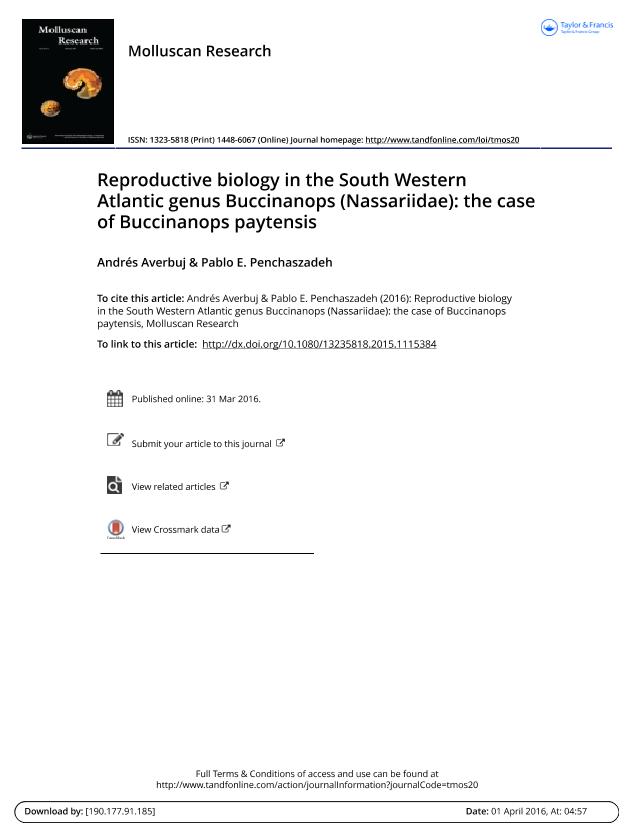Mostrar el registro sencillo del ítem
dc.contributor.author
Averbuj, Andres

dc.contributor.author
Penchaszadeh, Pablo Enrique

dc.date.available
2018-05-07T18:25:28Z
dc.date.issued
2016-03
dc.identifier.citation
Averbuj, Andres; Penchaszadeh, Pablo Enrique; Reproductive biology in the South Western Atlantic genus Buccinanops (Nassariidae): the case of Buccinanops paytensis; Magnolia Press; Molluscan Research; 36; 2; 3-2016; 75-83
dc.identifier.issn
1323-5818
dc.identifier.uri
http://hdl.handle.net/11336/44330
dc.description.abstract
The reproductive biology of the nassariid Buccinanops paytensis is considered and compared with the other species in the genus. In B. paytensis an average of 42 egg capsules were attached to the shell of each female. A mean of 2738 eggs (246 µm in diameter) occurred per capsule and generally only one embryo developed inside, measuring c. 5 mm in shell length when hatching; eggs at pre-hatching stage are still abundant. Four percent of the egg capsules contained two pre-hatching embryos of unequal size, in which nurse eggs were totally consumed. ‘Larval kidneys’ were recorded at advanced developmental stages (‘pediveliger’). Adaptations to reproduction in soft substrates involve a great amount of energy being invested by the females (nurse eggs and maternal care of the capsules), which enhance the survival of juveniles. Buccinanops paytensis had the highest number of nurse eggs per embryo (c. 2600), but B. cochlidium had more eggs and embryos per female (c. 3100 and c. 800, respectively). Hatching of crawling juveniles occurred in about 4 months in all species. When multiple embryos occur in an egg capsule, food becomes limiting, hatching size is reduced and unequal. Evidence of sibling cannibalism was observed in B. monilifer. Major differences are related to the spawn size, and the amount of nurse eggs and feeding modality of each species, which impact on the reproductive output (number and size of the juveniles) per female. The South African nassariid genus Bullia differs in egg capsule morphology and attachment, but is similar in having nurse eggs and direct development.
dc.format
application/pdf
dc.language.iso
eng
dc.publisher
Magnolia Press

dc.rights
info:eu-repo/semantics/openAccess
dc.rights.uri
https://creativecommons.org/licenses/by-nc-sa/2.5/ar/
dc.subject
Adelphophagy
dc.subject
Bullia
dc.subject
Egg Capsules
dc.subject
Intracapsular Development
dc.subject
Nurse Eggs
dc.subject
Parental Care
dc.subject.classification
Otras Ciencias Biológicas

dc.subject.classification
Ciencias Biológicas

dc.subject.classification
CIENCIAS NATURALES Y EXACTAS

dc.title
Reproductive biology in the South Western Atlantic genus Buccinanops (Nassariidae): the case of Buccinanops paytensis
dc.type
info:eu-repo/semantics/article
dc.type
info:ar-repo/semantics/artículo
dc.type
info:eu-repo/semantics/publishedVersion
dc.date.updated
2018-05-02T18:14:38Z
dc.identifier.eissn
1448-6067
dc.journal.volume
36
dc.journal.number
2
dc.journal.pagination
75-83
dc.journal.pais
Nueva Zelanda

dc.journal.ciudad
Auckland
dc.description.fil
Fil: Averbuj, Andres. Consejo Nacional de Investigaciones Científicas y Técnicas. Centro Científico Tecnológico Conicet - Centro Nacional Patagónico. Instituto de Biología de Organismos Marinos; Argentina
dc.description.fil
Fil: Penchaszadeh, Pablo Enrique. Consejo Nacional de Investigaciones Científicas y Técnicas. Oficina de Coordinación Administrativa Parque Centenario. Museo Argentino de Ciencias Naturales "Bernardino Rivadavia"; Argentina
dc.journal.title
Molluscan Research

dc.relation.alternativeid
info:eu-repo/semantics/altIdentifier/doi/https://dx.doi.org/10.1080/13235818.2015.1115384
dc.relation.alternativeid
info:eu-repo/semantics/altIdentifier/url/https://www.tandfonline.com/doi/full/10.1080/13235818.2015.1115384
Archivos asociados
